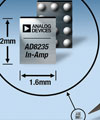Tiny, low-power in amp
2 September 2009
Analogue, Mixed Signal, LSI

Analog Devices has introduced what it claims is the industry’s smallest and lowest power instrumentation amplifier (in amp).
Smaller than the tip of a pencil, the miniscule size of the AD8235 makes it effective for power-efficient and portable, lightweight medical devices and consumer-health products, including home-use ECG (electrocardiogram) monitors, infusion pumps and activity-monitoring medical devices.
The device measures 1,6 x 2,0 mm and operates from 1,8 V and 5,5 V power supplies while drawing only 40 μA, making it suitable for other low-power applications, including consumer fitness products and industrial pressure and low-side current-sensing measurement equipment. These applications also benefit from the in amp’s 6 nA shutdown current and 40 pA bias current.
The AD8235’s wide common-mode input-voltage range (4 V and 1,4 V on 5 V and 1,8 V supplies respectively) is important for the low-voltage operation required by many battery-powered portable applications. A high common-mode rejection ratio (CMRR) of 86 dB (at a gain of 5) effectively eliminates common-mode interference.
Further reading:
Online sensor technology hub
Analogue, Mixed Signal, LSI
Mouser’s sensor content hub offers an extensive collection of articles, blogs, eBooks, and product information from its technical experts and leading manufacturing partners.
Read more...
Ultra-low power MEMS accelerometer
Altron Arrow
Analogue, Mixed Signal, LSI
Analog Devices’ ADXL366 is an ultra-low power, 3-axis MEMS accelerometer that consumes only 0,96 µA at a 100 Hz output data rate and 191 nA when in motion-triggered wake-up mode.
Read more...
BT Audio 4 Click board
Dizzy Enterprises
Analogue, Mixed Signal, LSI
The BT Audio 4 Click board from MIKROE provides high-quality wireless audio streaming and data comms over Bluetooth.
Read more...
Precision MEMS IMU modules
Altron Arrow
Analogue, Mixed Signal, LSI
The ADIS16575/ADIS16576/ADIS16577 from Analog Devices are precision, MEMS IMUs that includes a triaxial gyroscope and a triaxial accelerometer.
Read more...
MEMS with embedded AI processing
Altron Arrow
Analogue, Mixed Signal, LSI
STMicroelectronics has announced an inertial measurement unit that combines sensors tuned for activity tracking and high-g impact measurement into a single, space-saving package.
Read more...
High-performance IMU
RS South Africa
Analogue, Mixed Signal, LSI
TDK Corporation has announced availability of the new InvenSense SmartMotion ICM-536xx family of high-performance 6-axis IMUs.
Read more...
High-temperature closed-loop MEMS accelerometer
RS South Africa
Analogue, Mixed Signal, LSI
This sensor from TDK is a high-temperature MEMS accelerometer with ±14 g input range and a digital interface for measurement while drilling applications.
Read more...
Dual accelerometers on the same die
Altron Arrow
Analogue, Mixed Signal, LSI
The LSM6DSV320X is the first mainstream inertial sensor to house a gyroscope alongside two accelerometers, one capable of sensing up to ±16 g and one sensing up to a staggering ±320 g.
Read more...
Dual-range IMU with edge processing
EBV Electrolink
Analogue, Mixed Signal, LSI
ST’s innovative LSM6DSV80X combines two accelerometer structures for 16 g and 80 g full-scale sensing, a gyroscope up 4000 dps, and embedded intelligence in a single component.
Read more...
High-reliability isolation amplifiers
EBV Electrolink
Analogue, Mixed Signal, LSI
The VIA series of isolation amplifiers from Vishay are designed to deliver exceptional thermal stability and precise measurement capabilities.
Read more...


